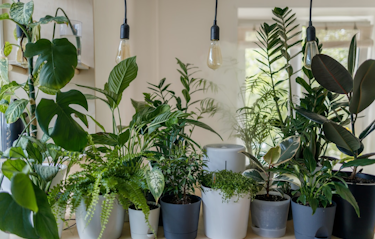
How To Trim Pothos
- Easy Care
- Araceae
- Large
- Evergreen Tropical Vines
We independently select everything we recommend. When you buy through our links, we may earn a commission.
To keep your Dieffenbachia plant happy, healthy, and looking beautiful, pruning is necessary to remove any dead or damaged leaves. This is generally an easy task, as all you need to do is cut or pinch back the plant above a leaf node.
Published on 07 August, 2023 by Oliver Rouane-Williams
Dieffenbachia, commonly called dumb cane, is a tropical plant that is a very popular houseplant because it is easy to grow and boasts full, often patterned foliage year-round.
First, you should always wear gloves while pruning a Dieffenbachia because the sap is poisonous and can cause skin irritation.
If you are pruning the plant to reduce its size, cut the upper stems back to a leaf node.
If you want to promote new growth and help your plant become bushier, remove top growth by pinching it, or if it is an older plant, use clean shears or pruners. New leaves will begin to come in just below the cut.
If you want to remove brown, damaged leaves, remove the leaf up to the stem, but do not cut into the stem. If your leaves have brown edges on them, you can cut just the damaged part off by following the curve of the leaf.
Always ensure that you are using a clean cutting tool to prevent disease or damage to the plant. Make cuts about 1/4 of an inch above a leaf node and cut at a 45-degree angle for best results.
Never cut more than a third of the plant’s foliage. Also, you can use your stem cuttings for the propagation of the dumb cane plant to grow new plants.

Unlike several other indoor plants that can only be pruned during their growing season, the Dieffenbachia can be pruned at any time.
Pruning is not always necessary, but you will want to ensure that your plant stays happy and healthy, so trimming dead or damaged leaves is important.
In order to keep your dumb cane plant looking healthy, you will need to remove any yellow and brown leaves from the plant.
The most common problem with Dieffenbachia plants is overwatering, which can then lead to yellowing lower leaves. Underwatering your plant could also be a culprit, as well as too much direct sunlight or other less-than-ideal light conditions, pest attacks, or cold weather.
Plant care for Dieffenbachia is rather easy, but sometimes things happen. If you notice your dumb cane’s leaves turning yellow or brown in color, make sure it has optimal growing conditions.
Check that the room temperature is between 65 and 75 degrees Fahrenheit, and humidity is around 60% (you may want to invest in a humidifier to reach these conditions).
Also, you’ll want to keep the soil moist, but not waterlogged, at all times so that it doesn’t dry out. However, overwatering can cause yellow leaves or even lead to root rot.
Use a well-draining potting soil and repot your plant in a new pot with drainage holes if the yellow and brown leaves persist after adjusting growing conditions.

To prune a leggy Dieffenbachia, simply cut back the long stems to just above a leaf node, or the point where a leaf meets the stem. The term leggy simply means that the stem is very long with few leaves toward the top.
Normally, the main reason Dieffenbachia becomes leggy is that it’s not getting enough light. Consider moving your plant out of the low-light area and into a spot where it can receive bright indirect light.
Delivered to your inbox every Saturday morning








